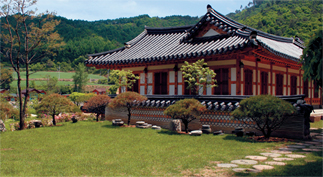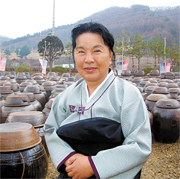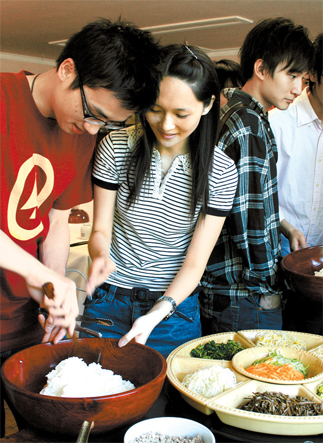Preserving the history of Korean food from her house

Drying garlic and bean paste jars. Photos by Lee Eun-joo

The hanok in Jungkangwon, an institution for traditional Korean cuisine.
Walking closer to the main hanok, a traditional Korean-style house, in Jungkangwon, an institute of traditional Korean cuisine, you see hundreds of reddish-brown jar stands filled with doenjang (soybean paste) or gochujang (hot pepper paste), adding extra aroma to the air.
The jars are buried in salt and charcoal to keep fermented pastes fresh.
What you see here is rustic.
Garlic hangs from the hanok rooftop piled with wooden vessels, and a lotus pond reminds one of a Joseon scene.

Cho Jung-kang, the founder of the cuisine institute.
Cho, 70, built the traditional house in 2005 to preserve, develop and educate people about Korean food. There are daily cooking classes, with reservations needed. Prices vary. The most popular tour runs 90 minutes and costs 20,000 won ($19.50).
“The influx of imported Western foods threatens the dining tables of Koreans today,” Cho said.
Her story begins in 1999, when she invested 3 billion won ($2.9 million) to buy land in Pyeongchang to build the traditional complex. The construction took seven years.
The surrounding was perfect for fermenting foods. And nature was all around - mountains and streams.
“People say the mecca of Korean cuisine is Jeonju, but the flavor is too strong,” Cho said. “Instead, I prefer cuisine from Gangwon Province ? it’s more mild.”
It wasn’t easy to start such an unpredictable business. She had to let go of her stable life as a well-known restaurant owner.

Timothy Wong from Hong Kong mixes rice for bibimbap.
The restaurant branched out after opening in Seogyo-dong near Hongik University in Seoul. Former presidents Choi Kyu-ha, Chun Doo Hwan and Kim Young-sam often visited.
“My food doesn’t contain any artificial flavoring,” she said.
Cho inherited traditional cooking skills from her grandmother.
In fact, she is the 12th descendent of Cho Heon (1544-1592), who led an army during the Japanese invasion of Korea in 1592.
Pursuing justice and loyalty, he led some 1,700 soldiers, including monks, to recapture taken land. Most died in the battle, himself included.
Cho wanted to preserve that spirit flowing through her family’s blood.
“Korean culture and cuisine should be taught properly,” she said. “And Koreans should be proud.”
But first you need to be educated, she says.
The institution has traditional cooking kits, a museum, hanok seminar rooms and an icehouse kept at 1 to 5 degrees Celsius (33.8 to 41 F) all year round.
All the recipes taught strictly follow traditional form ? from ingredient selection, cultivation, cooking and storage.
But business wasn’t always easy.
The summer after Cho built the institution, heavy rain soaked ingredients, including soybean paste and kimchi. Some parts of the hanok are still under reconstruction.
“Words cannot express how shocked I was to see things collapse in no time,” she said.
But the incident steeled her to drive toward her goal ? establishing a school for traditional Korean cuisine.
“Fewer and fewer households make kimchi,” she said. “Naturally, some are not familiar with the process.”
She pictures an image of a royal kitchen depicted in the historical TV drama, “The Jewel in the Palace.”
With help from others, her vision is nearing fruition.
Yoo Myung-hwan, an official at the Gangwon provincial government office said, “Though there are no specific plans yet, we hope to turn the place into an educational tourist site.”
Cho’s youngest daughter, Kim Joo-sung, is also pitching in. Though she was an undergraduate industrial arts major, she decided to study food engineering for her master’s and doctorate.
Last week, Kim was making bibimbap with Han Young-soon, the general manager of the institute, and some 20 students from Hong Kong.
“The bibimbap recipe is inherited from the family ? it is 400 years old,” Kim said, while gently sorting one of the 18 vegetables on rice before mixing it with gochujang.
“It is said that you need a daily intake of 18 vitamins,” she said.
“Instead of taking concentrated supplements, why not eat a bowl of bibimbap?” she said.
After making bibimbap, Han led a group tour of the hanok.
“Hanoks have high ceilings,” Han said. “And there is hidden wisdom behind the architecture.” The high ceiling made of pine wood helps the air circulate better.
Visitors can spend a night here with a reservation.
Timothy Wong, a student from City University of Hong Kong, wanted to stay overnight if time allowed.
“Korean culture is high and noble, especially the cuisine,” Cho said.
“But it has been left out in the cold. It is now time to bring it back to our lifestyle.”
To reach Jungkangwon, take a bus from Dongseoul Bus Terminal (Gangbyeon Station, line No. 2) to Jangpyeong. The two-hour ride ticket costs 10,500 won. It is a three-minute taxi ride from Jangpyeong Terminal.
Call (033) 333-1011 or visit www.krtfce.com.
To learn about royal Korean cuisine in Seoul, visit the Institute of Royal Korean Cuisine, (02) 3673-1122, in Anguk-dong, central Seoul.
By Lee Eun-joo Staff Reporter [angie@joongang.co.kr]










with the Korea JoongAng Daily
To write comments, please log in to one of the accounts.
Standards Board Policy (0/250자)